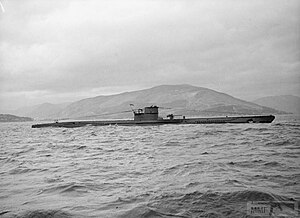
Summary
German submarine U-776 was a Type VIIC U-boat of Nazi Germany's Kriegsmarine during World War II.
 U-570 Type VIIC submarine that was captured by the British in 1941. This U-boat is almost identical to U-776.
| |
| History | |
|---|---|
| Name | U-776 |
| Ordered | 21 November 1940 |
| Builder | Kriegsmarinewerft, Wilhelmshaven |
| Yard number | 159 |
| Laid down | 4 March 1943 |
| Launched | 4 March 1944 |
| Commissioned | 13 April 1944 |
| Fate |
|
| General characteristics | |
| Class and type | Type VIIC submarine |
| Displacement | |
| Length |
|
| Beam |
|
| Height | 9.60 m (31 ft 6 in) |
| Draught | 4.74 m (15 ft 7 in) |
| Installed power |
|
| Propulsion |
|
| Speed |
|
| Range | |
| Test depth |
|
| Complement | 4 officers, 44–52 enlisted |
| Armament |
|
| Service record | |
| Part of: |
|
| Identification codes: | M 15 421 |
| Commanders: | |
| Operations: |
|
| Victories: | None |
She was ordered on 21 November 1940, and was laid down on 4 March 1943, at Kriegsmarinewerft, Wilhelmshaven, as yard number 159. She was launched on 4 March 1944, and commissioned under the command of Oberleutnant zur See Lothar Martin on 13 April 1944.[2]
Design edit
German Type VIIC submarines were preceded by the shorter Type VIIB submarines. U-776 had a displacement of 769 tonnes (757 long tons) when at the surface and 871 tonnes (857 long tons) while submerged.[3] She had a total length of 67.10 m (220 ft 2 in), a pressure hull length of 50.50 m (165 ft 8 in), a beam of 6.20 m (20 ft 4 in), a height of 9.60 m (31 ft 6 in), and a draught of 4.74 m (15 ft 7 in). The submarine was powered by two Germaniawerft F46 four-stroke, six-cylinder supercharged diesel engines producing a total of 2,800 to 3,200 metric horsepower (2,060 to 2,350 kW; 2,760 to 3,160 shp) for use while surfaced, two Garbe, Lahmeyer & Co. RP 137/c double-acting electric motors producing a total of 750 metric horsepower (550 kW; 740 shp) for use while submerged. She had two shafts and two 1.23 m (4 ft) propellers. The boat was capable of operating at depths of up to 230 metres (750 ft).[3]
The submarine had a maximum surface speed of 17.7 knots (32.8 km/h; 20.4 mph) and a maximum submerged speed of 7.6 knots (14.1 km/h; 8.7 mph).[3] When submerged, the boat could operate for 80 nautical miles (150 km; 92 mi) at 4 knots (7.4 km/h; 4.6 mph); when surfaced, she could travel 8,500 nautical miles (15,700 km; 9,800 mi) at 10 knots (19 km/h; 12 mph). U-776 was fitted with five 53.3 cm (21 in) torpedo tubes (four fitted at the bow and one at the stern), fourteen torpedoes or 26 TMA mines, one 8.8 cm (3.46 in) SK C/35 naval gun, (220 rounds), one 3.7 cm (1.5 in) Flak M42 and two twin 2 cm (0.79 in) C/30 anti-aircraft guns. The boat had a complement of between 44 — 52 men.[3]
Service history edit
U-776 participated in one war patrol that yielded no ships sunk or damaged.[2]
On 16 May 1945, U-776 surrendered at Portland, UK. For a brief time she was designated N-65, a British N-class submarine, and toured the British coast and used for tests. She was later transferred to Loch Ryan, Scotland. Of the 156 U-boats that eventually surrendered to the Allied forces at the end of the war, U-776 was one of 116 selected to take part in Operation Deadlight. U-776 was towed out on 3 December 1945, but sank after foundering on the way to the designated area. She was one of 56 U-boats that sank before reaching the scuttling areas.[2]
The U-776, one of the German submarines which were surrendered at Weymouth is now moored to Westminster Pier, close by the Houses of Parliament, and will open to public inspection tomorrow. Our pictures show the submarine on her arrival at Westminster and a view of the engine room.
— Wednesday 23 May 1945 - London, "Surrendered U-BOAT at Westminster Pier", The Times
The wreck now lies at 55°08′N 05°30′W / 55.133°N 5.500°W.[2]
References edit
Bibliography edit
- Busch, Rainer; Röll, Hans-Joachim (1999). German U-boat commanders of World War II : a biographical dictionary. Translated by Brooks, Geoffrey. London, Annapolis, Md: Greenhill Books, Naval Institute Press. ISBN 1-55750-186-6.
- Busch, Rainer; Röll, Hans-Joachim (1999). Der U-Boot-Krieg, 1939-1945: Deutsche U-Boot-Verluste von September 1939 bis Mai 1945 [German U-boat losses from September 1939 to May 1945] (in German). Vol. IV. Hamburg, Berlin, Bonn: Mittler. ISBN 3-8132-0514-2.
- Gröner, Eric; Jung, Dieter; Maass, Martin (1991). German Warships 1815-1945: U-boats and Mine Warfare Vessels. Vol. 2. Translated by Thomas, Keith; Magowan, Rachel. London: Conway Maritime Press. ISBN 0-85177-593-4.
External links edit
- Helgason, Guðmundur. "Patrols by U-776". German U-boats of WWII - uboat.net.


